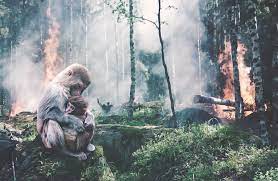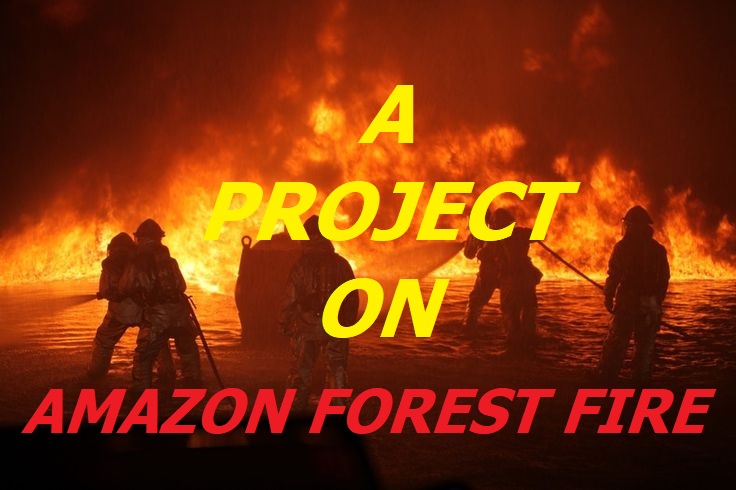Project On Amazon Forest Fire: Everything You Need To Know
Here is a project on Amazon Forest Fire for the students of Science and Social Science. In this Blog article, you will get everything you need to know about the Amazon Forest Fire. You already know that the Amazon, the greatest rainforest in the world, has been burning for more than 16 days and is in danger of going entirely out of control. The rainforest, which provides over 20% of the planet’s oxygen, is suffering greatly from a loss of trees and biodiversity. An environment on which the entire world depends, the Amazon, is experiencing unprecedented fires. Therefore, without any delay, let’s begin the project on Amazon Forest Fire.
Project On Amazon Forest Fire: Everything You Need To Know
Causes Of Amazon Forest Fire
The Amazon forest fires are primarily caused by human activities, including:
Deforestation
Clearing large areas of forest for agriculture, cattle ranching, and urbanization is a major cause of Amazon fires.
Agricultural and Livestock Practices
Fires are often used as a tool for clearing land for crops or pasture for livestock.
Illegal Activities
Some fires are set illegally for illegal activities like mining, logging, and hunting.
Natural Causes
Drought conditions, dry lightning strikes, and other natural phenomena can also start fires in the Amazon.
It is important to note that human activities are the primary cause of the Amazon forest fires and natural factors are secondary.
The increasing frequency and severity of these fires are a result of human activities that have altered the Amazon ecosystem.
“Project On Heat Stroke”- Understanding the Risks and Prevention
Loss Due To Amazon Forest Fire
The Amazon forest fires have significant consequences for both the environment and human communities:
Biodiversity Loss
The Amazon is home to a vast array of plant and animal species, many of which are found nowhere else in the world.
The fires destroy habitat and disrupt the delicate balance of the ecosystem, leading to species loss.
Climate Change
The Amazon rainforest plays a critical role in regulating the Earth’s climate by absorbing large amounts of carbon dioxide from the
atmosphere.
When the forest is burned, this carbon is released back into the atmosphere, exacerbating the effects of climate change.
Health Impacts
The smoke and ash produced by the fires can have serious impacts on air quality and human health, especially for communities living in the
region.
Economic Loss
The Amazon is a major source of livelihood for indigenous communities and local economies, providing food, medicine, and materials for
shelter and clothing.
The destruction of the forest has serious impacts on these communities and their ability to sustain themselves.
Soil Erosion
The loss of trees and vegetation due to fires can lead to soil erosion and degradation, making it more difficult for the forest to recover and for
new growth to establish itself.
10 Page Project On Turkey Earthquake: Do You Really Need It? This Will Help You Decide
Project On Amazon Forest Fire: Everything You Need To Know

AMAZON FORESTS AFTER FIRE. COURTESY: PIXABAY
Steps To Be Taken To Control Forest Fire
There are several steps that can be taken to control and prevent forest fires:
Land-Use Planning
Implementing sustainable land-use policies that limit deforestation and promote the conservation of forests can help prevent fires.
Fire Management
Firefighters and other emergency personnel need to be equipped and trained to effectively respond to and control forest fires.
Community Involvement
Engaging communities living in and around the forest in fire prevention and management efforts can help reduce the number of fires and
increase local ownership of conservation efforts.
Fire-resistant Plantations
Planting fire-resistant species of trees and vegetation can reduce the risk of fires spreading in forests.
Monitoring and Early Detection
Regular monitoring of forests and early detection of fires can help reduce their impact and facilitate quicker responses to control the spread
of fires.
Law Enforcement
Strict enforcement of laws and regulations against activities that contribute to deforestation and forest fires, such as illegal logging and slash-
and-burn agriculture is crucial.
Reforestation and Restoration
Restoration and reforestation efforts can help repair damaged forests and restore their ability to perform important ecosystem functions,
such as carbon sequestration and wildlife habitat.
11 Points You Must Include In Your Disaster Management Project On Climate Change
Role Of Community In Reducing The Impact Of Amazon Forest Fire
The role of local communities in reducing the impact of Amazon forest fires is crucial.
Some of the ways in which communities can help include:
Fire Management
Communities living near the forest can play a role in detecting and reporting fires and in supporting fire management efforts.
Sustainable Land Use Practices
Communities can adopt sustainable land-use practices, such as agroforestry and conservation agriculture, to reduce the need for
deforestation and reduce the risk of fires.
Awareness and Education
Raising awareness about the importance of the Amazon rainforest and the impacts of fires on both the environment and local communities
can encourage greater protection and conservation efforts.
Conservation Efforts
Communities can participate in conservation efforts, such as reforestation and habitat restoration, to help repair damaged areas and prevent
future fires.
Monitoring and Reporting
Community members can be trained to monitor their local forests and report any signs of illegal activities, such as illegal logging or land
clearance, which may lead to fires.
Support for Alternative Livelihoods
Communities can be supported in transitioning to alternative livelihoods that are less harmful to the forest, such as ecotourism, to reduce
the pressure on the forest and reduce the risk of fires.
By working together, communities and other stakeholders can help reduce the impacts of Amazon forest fires and protect this important
ecosystem for future generations.
Project On Amazon Forest Fire: Everything You Need To Know

COURTESY: PIXABAY
Steps Taken By The Government To Control Forest Fire
Governments play a crucial role in preventing and controlling forest fires. Some of the steps that governments can take include:
Land-Use Planning
Governments can implement sustainable land-use policies that limit deforestation and promote the conservation of forests, reducing the risk
of fires.
Fire Management
Governments can invest in fire management infrastructure, such as firefighting personnel, equipment, and training, to effectively respond to
and control forest fires.
Law Enforcement
Governments can enforce laws and regulations that prohibit activities that contribute to deforestation and forest fires, such as illegal logging
and slash-and-burn agriculture.
Monitoring and Early Detection
Governments can support monitoring and early detection systems to quickly detect and respond to forest fires.
Community Involvement
Governments can engage and support local communities in fire prevention and management efforts, raising awareness and building capacity.
Reforestation and Restoration
Governments can invest in reforestation and restoration efforts to repair damaged areas and restore the health of the forest.
International Cooperation
Governments can collaborate with other countries to address regional and global environmental issues, such as climate change and
deforestation, which contributes to the risk of forest fires.
By taking a comprehensive and coordinated approach, governments can help reduce the risk of forest fires and protect important ecosystems
for future generations.
Kaziranga National Park Project – How To Complete In Just Three Hours?
Adverse Effect Of Forest Fire On The Environment
Forest fires have several adverse effects on the environment:
Biodiversity Loss
Forest fires can destroy large areas of forests, causing the loss of plant and animal species, as well as their habitats.
Soil Degradation
Intense heat from fires can cause soil to become compact and infertile, reducing its ability to support vegetation growth.
Air Quality
Forest fires can release large amounts of smoke and pollutants into the air, affecting air quality and causing respiratory and health problems
for both people and wildlife.
Carbon Emissions
Forest fires are a significant source of carbon emissions, contributing to climate change and exacerbating global warming.
Hydrology
Forest fires can alter the water cycle and disrupt the flow of streams and rivers, affecting the availability of water for both humans and
use.
Human Health
Exposure to smoke and other pollutants from forest fires can cause respiratory and health problems for people living in and around the
affected areas.
Economic Impacts
Forest fires can cause significant economic losses, including damage to infrastructure and loss of livelihoods for communities that depend on
the forest for their livelihoods.
In addition to the direct impacts of forest fires, the loss of forests also has broader impacts on the climate and the environment, as forests
play a crucial role in carbon sequestration, water regulation, and biodiversity conservation.
Clear And Unbiased Facts About Project On Global Warming
Amazon Forest Fire: Effects On Wildlife

COURTESY: PIXABAY FREE IMAGES
Forest fires have significant adverse effects on wildlife.
Habitat Loss
Forest fires can destroy large areas of habitats, causing the loss of food and shelter for many species.
Species Extinction
Forest fires can cause the extinction of rare and endangered species that may not be able to adapt to the changing conditions caused by the
fire.
Displacement
Forest fires can displace wildlife from their homes, leading to increased competition for food and habitat and a higher risk of predation.
Stress and Injury
Forest fires can cause physical stress and injury to wildlife, including burns, smoke inhalation, and other respiratory problems.
Altered Ecosystems
Forest fires can change the structure and composition of ecosystems, affecting the interactions between species and altering the balance of
the food chain.
Reduction in Prey
Forest fires can reduce the availability of prey species, leading to declines in populations of predators that depend on these species for food.
Loss of Genetic Diversity
Forest fires can cause the loss of genetic diversity, as smaller populations are more vulnerable to inbreeding and genetic drift.
In addition to these direct impacts, forest fires can also cause long-term changes to ecosystems, affecting the survival and resilience of
wildlife populations.
It is therefore crucial to take steps to prevent and control forest fires to protect wildlife and maintain the health of ecosystems.
Project On Amazon Forest Fire: Everything You Need To Know
Conclusion
The Amazon forest fire is a significant environmental issue that has far-reaching impacts on the planet. The destruction of the Amazon rainforest contributes to climate change by releasing large amounts of carbon into the atmosphere, reducing the forest’s ability to absorb carbon, and altering local weather patterns. It also impacts indigenous communities, and wildlife, and threatens the biodiversity of the region. To address this issue, it is necessary for governments, corporations, and individuals to take action to reduce deforestation, implement sustainable land-use practices, and promote reforestation. This can include reducing the demand for products that drive deforestation, such as beef, soy, and palm oil, as well as supporting conservation efforts and investing in renewable energy sources.





0 Comments